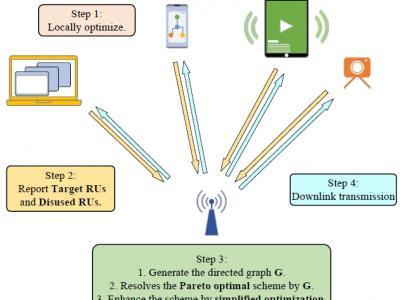Resource allocation
Abstract—In recent years, there has been a significant advancement
in the field of healthcare systems with the introduction
of fifth generation cellular communications and beyond (5GB).
This development has paved the way for the utilization of
telecommunications technologies in healthcare systems with an
level of certainty, reaching up to 99.999 percent. In this paper,
we present a novel task computing framework that can address
the requirements of healthcare systems, such as reliability. In
- Categories:
 323 Views
323 Views
In the evolving landscape of 5G network, network slicing has been considered as a key technology for the realization of multiple virtual networks running on a shared physical infrastructure, each designed to fulfill a specific service or application. However, with such networks, the dynamic and real-time allocation of these resources remains a prime concern, particularly with respect to highly variable conditions of traffic.
- Categories:
 302 Views
302 ViewsDistributed-Optimization with Centralized-Refining (DO-CR) mechanism to achieve more efficient resource allocation by engaging both access point and all devices. Specifically, the new DO-CR mechanism first utilizes the distributed processing capacity of all devices, allowing them to optimize their own resource allocation schemes through a new resource reservation and reporting technique. Then a centralized optimizer generates a graph of resource trading topology based on individual optimization results and achieves the Pareto optimal solution by the graph-based algorithm.
- Categories:
 162 Views
162 ViewsThis paper investigates resource management in device-to-device (D2D) networks coexisting with mobile cellular user equipment (CUEs). We introduce a novel model for joint scheduling and resource management in D2D networks, taking into account environmental constraints. To preserve information freshness, measured by minimizing the average age of information (AoI), and to effectively utilize energy harvesting (EH) technology to satisfy the network’s energy needs, we formulate an online optimization problem.
- Categories:
 468 Views
468 ViewsIntelligence and flexibility are the two main requirements for next-generation networks that can be implemented in network slicing (NetS) technology.This intelligence and flexibility can have different indicators in networks, such as proactivity and resilience. In this paper, we propose a novel proactive end-to-end (E2E) resource management in a packet-based model, supporting NetS.
- Categories:
 441 Views
441 ViewsThis paper investigated how to increase the number of connections among users in hierarchical non-terrestrial networks (HNTNs) assisted disaster relief service (DRS). We aim to maximize the number of satisfactory connections (NSCs) by optimizing the unmanned aerial vehicles (UAV) radio resources, computing resources, and trajectory at each time slot. In particular, the UAVs are exploited as aerial base stations (ABSs) to provide a link for the reduced capability (RedCap) user equipment (UE) based on power domain non-orthogonal multiple access (PD-NOMA).
- Categories:
 609 Views
609 Views
In this paper, we propose a novel resource management scheme that jointly allocates the transmit
power and computational resources in a centralized radio access network architecture. The network
comprises a set of computing nodes to which the requested tasks of different users are offloaded. The
optimization problem minimizes the energy consumption of task offloading while takes the end-to-end latency, i.e., the transmission, execution, and propagation latencies of each task, into account. We aim to
- Categories:
 857 Views
857 ViewsThe simulation code for the paper:
"AoI-Aware Resource Allocation for Platoon-Based C-V2X Networks via Multi-Agent Multi-Task Reinforcement Learning"
The overall architecture of the proposed MARL framework is shown in the figure.
Modified MADDPG: This algorithm trains two critics (different from legacy MADDPG) with the following functionalities:
- Categories:
 1102 Views
1102 Views
# -*- coding: utf-8 -*-
"""
Created on Wed Feb 26 11:19:38 2020
@author: ali nouruzi
"""
import numpy as np
import random
- Categories:
 503 Views
503 Views


